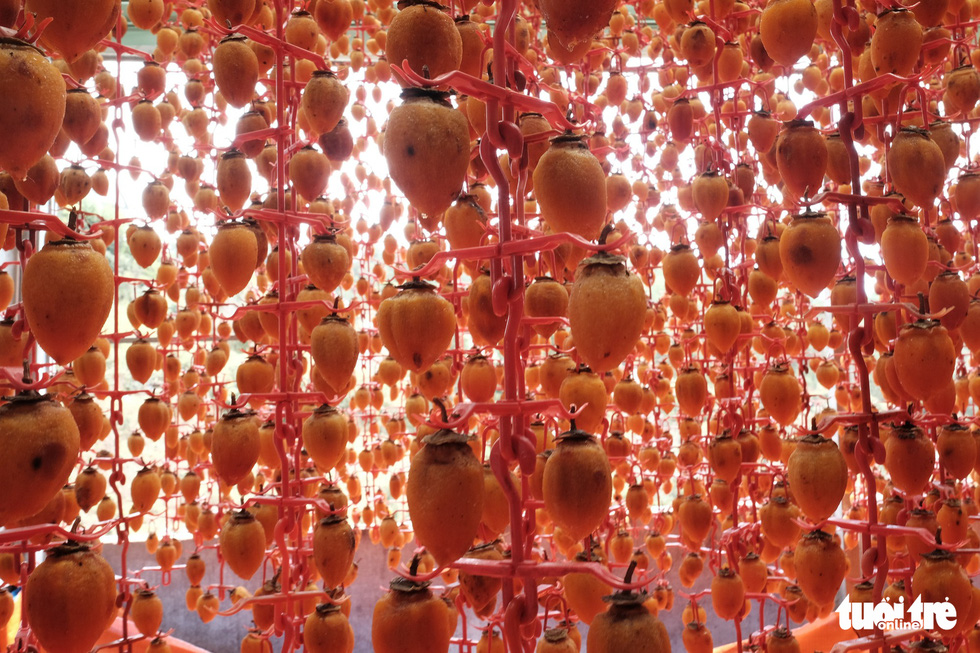Hoshigaki, or persimmons prepared with traditional Japanese techniques, have saved Da Lat’s dried persimmon industry.
Hoshigaki are persimmons dried with traditional Japanese techniques which take advantage of wind and sunlight.
Through a combination of hanging, hand-massaging, wind, and sunshine, the fruit forms a delicate surface with dust-like particles.
Unlike sliced dried fruit, which tends to be brittle and leathery, Hoshigaki are succulently tender and moist, while still having a persimmon flavor.
 |
| The fruit forms a delicate surface with dust-like particles. Photo: Tuoi Tre |
In 2012 the technique was first introduced to Da Lat, a highland area of Vietnam known for its dried fruits, beautiful flowers, and jams, when the persimmon industry was at stake there.
During that time, many Japanese farmers and professionals from the Japan International Cooperation Agency branch in Vietnam came to Da Lat to instruct over 100 farming families in the Hoshigaki technique, which only uses wind rather than coal and firewood for drying.
However, it was not until 2014 that the technique was truly used for production.
Shortly after the traditional Japanese drying technique was implemented, Da Lat’s persimmons became well known and preferred by many people.
Hoshigaki’s price then became two times that of the regular dried persimmons, sometimes even up to three to four times the rate of those dried by coal and firewood.
According to the Da Lat People’s Committee, thanks to the Japanese technique, the persimmon drying industry in the city has been saved and thus the persimmon trees have ceased to be chopped down.
Before the application of the drying technique, persimmons fetched around VND2,000 (US$0.085), barely enough for farmers to cover the harvesting cost.
Thanks to the growing need for dried persimmons, the price is now around VND10,000 ($0.43), but it varies and may be higher at the beginning and end of the harvest season.
 |
| The persimmons require regular massaging to come out with the best quality. Photo: Tuoi Tre |
Nectar is the essence of fruit
Dang Thi Thu Van, the 57-year-old owner of the Le Van dried fruit manufacturing business, was one of the first Da Lat producers to implement the Japanese technique.
According to Van, the process begins when the fruit has not ripened and is still hanging on the tree.
 |
| Persimmon trees. Photo: Tuoi Tre |
Collected fruits are washed and peeled, with their stem left hanging.
The persimmon is then dried with coal in a short time to make the fruit skin firm.
After that, the fruit is hung in a greenhouse for 25 days, during which it will become ripe.
The main advantage of this technique is that the fruit will be dried naturally and will keep its tenderness, sweetness, as well as persimmon flavor.
But since this technique depends mainly on natural light and wind, unpredictable weather may affect its efficiency.
 |
| Persimmons are hung to dry in glass houses. Photo: Tuoi Tre |
“A good Hoshigaki persimmon is the one with a stem. Looking at it, customers can picture how round and nice the fruit looked when it was still fresh,” Van said.
“Inside, there is still nectar, which is the essence of this dried fruit.”
According to farmers trained by the Japan International Cooperation Agency, Hoshigaki are often enjoyed with tea in Japan.
In order to store the dried fruits for a long time, they can be put in a freezer.
 |
| The fruit is selected to guarantee the best quality. Photo: Tuoi Tre |
 |
| The best fruits are peeled, leaving only the stem so as to be naturally dried with wind and sunlight. Photo: Tuoi Tre |
 |
| The persimmons are hung on plastic hangers. Photo: Tuoi Tre |
Like us on Facebook or follow us on Twitter to get the latest news about Vietnam!


















































